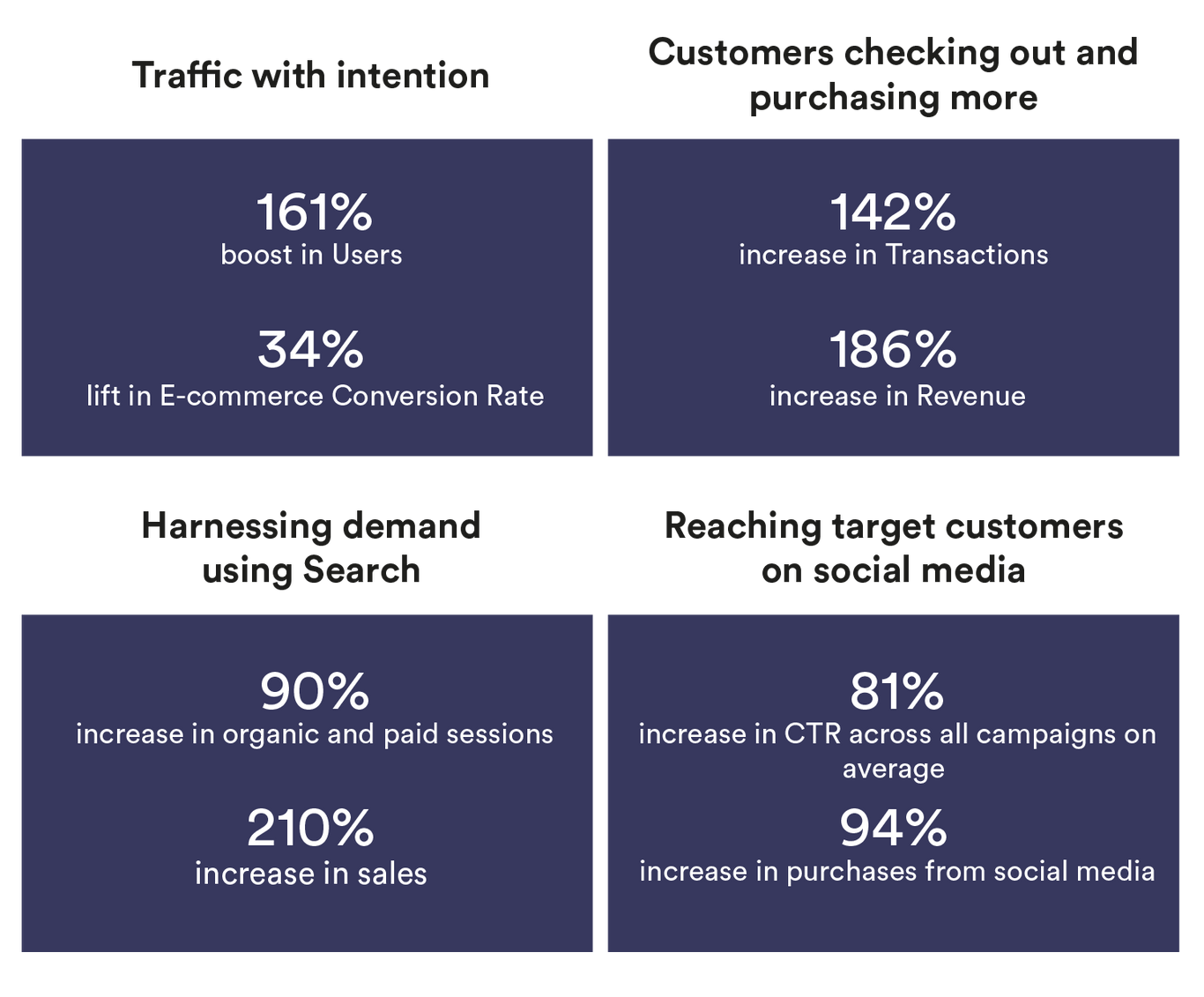Strategy
Why your marketing strategy needs AI (in 2022 and beyond)
02/24/22
How can you unlock a stronger digital presence? For us, the artificial intelligence (AI) key will open multiple doors for your marketing strategy’s success. At Nordic Morning, AI has helped us achieve traffic and revenue growth for our clients on the back of a solid data-driven strategy.
Here we’ll explore how you leverage AI to make your digital marketing truly customer-focused and data-driven.
What is a marketing strategy?
A marketing strategy is simply an action plan that’s designed to reach a target audience and convert them into customers. An organization must use the resources available to them to maximize sales opportunities and achieve their marketing goals.
As AI continues to become much more prevalent, it’s fast becoming not only a significant contributor to a more seamless customer experience, but it also enables marketers to predict what their customers want. In other words, using predictive technology in the right way can create an incredibly effective action plan for your digital marketing activities to reach its desired audience.
Using AI in your marketing means that patterns can be recognized from masses of gathered data and predictions can be made—without the need for a specific programming command.
It’s time to ask yourself: Am I putting my data to the best use?
How marketers are utilizing AI
AI is here to stay. Optimizing your marketing automation today is a fundamental factor for achieving digital growth tomorrow. There may be no one-AI-solution-fits-all when it comes to meeting your marketing needs, however, automated decision making gives marketers a significant advantage in out-innovating the competition.
From the efficiency of improved prediction systems leveraging machine learning, to delivering tailored, personalized messages, AI is changing the game for marketing activities.
Let’s dig deeper into the benefits of AI marketing.
The power of AI for personalized marketing
Let’s get personal. Reaching your audience is one thing. Providing a real-time personalized experience is on a whole other level. The fact is personalized marketing needs the help of AI. By leveraging data analysis and digital technologies, companies can deliver a more personalized user experience through customized messaging and relevant product offerings to the right customer. When it comes to your marketing strategy, AI helps to adopt a one-to-one optimization approach as opposed to a one-to-as-many-as-possible approach. AI ensures that it's only those interactions with true value that customers engage with by removing unnecessary ones.
As a digital marketer in 2022, a cross-channel marketing strategy is nothing new. The seamlessness of hopping from device to device and channel to channel demands that all areas of communication are covered. Therefore, your marketing campaigns must be designed to fit the needs of these multiple device experiences. Succeeding in personalizing your customer experiences across devices leads to increased customer satisfaction, which means improved customer relations and a much better chance of customer loyalty.
Improved return on investment
Speaking of marketing campaigns, when it comes to significantly boosting your return on investment (ROI) for your efforts, AI becomes invaluable by creating more effective customer touchpoints. By eliminating much of the guesswork involved in customer interactions, AI delivers an ad experience that is more personalized for each user. Machine learning, together with paid search and social create a much-improved personalized user experience.
First, a structured approach to paid search and social is required to deliver the best results. Here’s how we break it down:
- Audience first: Put your audience center-stage. Use data to understand your audience and from there, you can serve the right message at the right time to the right people.
- Reach and engage: Content should make customers feel, see, think, or do. Always include (targeted) paid social ads to generate the right level of impressions and make them care.
- Business objectives and Key Performance Indicators (KPIs): It goes without saying that the focus should fall on meaningful business objectives and KPIs that will optimize your channels and performance.
From here, you can start thinking about setting an attribution model using attribution AI. Google describes the attribution model as
the rule, or set of rules, that determine(s) how credit for sales and conversions is assigned to touchpoints in conversion paths.
But why is attribution important to your marketing?
Attribution AI
Most of our decisions are data-driven and based on analytics. Data-driven attribution gives credit for conversions based on how people engage with your variety of ads and convert to become customers. Attribution AI uses data from your account to determine which keywords, ads, and campaigns have the greatest impact on your business goals. The goal of attribution is to determine which channels and communication have the greatest impact on the decision to convert. There are several different attribution models where multi-touch attribution is one that takes all the touchpoints on the consumer journey into consideration and assigns fractional credit to each to determine how much influence each channel has on a conversion.
Once your audience and tracking are in place, AI collects all data to optimize and perform towards your strategy. For example, with a clear cost per acquisition (CPA) level, AI can optimize its performance under that CPA level to increase your ROI. From here on in, you let the algorithms do the work for you. Try to test the A/B version and based on conversion value, let AI choose which version goes where for what audience.
The qualitative benefits of AI models
At Nordic Morning, we believe that one of the biggest challenges of data-driven advertising is to stay on track with regards to themes and qualitative attributes of creatives delivered in online channels.
By “creatives”, we mean an ad (image, audio, video) that’s served to users in a digital environment. To analyze different visual themes of creatives, we need to be 100 percent accurate and standard with naming conventions.
How about if AI could help us with this?
Google Cloud AI use case
In a recent use case, we looked in-depth at Google Cloud AI features for marketing insights. The specific focus fell upon the creative AI analysis. The goal was to leverage the AI models of Google's Cloud Vision API for automated analysis, theme identification, and ranking of advertising materials.
The “qualitative classification” created by AI could be combined with data accumulated in different advertising materials to determine how different themes (joy, sadness, and so on) and subjects (such as human images, room images, male images, female images) appear in the advertising illustrations based on the data (click-through rate, conversions, and the like).
As the classification of advertising material is based on naming criteria, it’s entirely up to the author of the ad what “qualitative attributes” they want to attach to the ad. As a result, it can be difficult to form a “standard” way of defining qualitative definitions, as well as to determine whether an illustration conveying one emotion is more effective than an artwork conveying another.
Automatic AI labelling of materials solves this problem. How? Because analysis functionality can be built using the AI models of the Vision API, and data management can be built using, for example, the Google Cloud infrastructure.
So, how does this benefit the user?
Based on AI's ratings, users are constantly able to see what advertising is going on and how it has performed in real time. Messages and themes from main competitors at any given time can be included in the set as automation retrieves the data and the AI classifies them.
In collecting long-term data, and utilizing the classifications made by AI, you’re able to strengthen your market position as a builder of better experiences. AI classifies your planned illustrations and messages, and from that you get the most optimal suggestions that reflect the historical data on which of the materials would perform best.
Case study: Creating a strategy for data-driven online advertising and tracking
The challenge
In a highly competitive, traditionally “brick-and-mortar” space, our client, a leading design furniture reseller, wanted to style themselves as the option of choice for premium design furniture and home accessories online. Their goal was to give their customers the same high-end service online, that they were used to receiving in-store. The approach was clear: our client needed to become more data-driven in their advertising to unlock a stronger digital presence. Nordic Morning was selected to ensure they could reach the full potential of their digital audience and to explore the opportunities which strategic analytics, SEO, SEM, and marketing automation had to offer.
The solution
We focused on what we know best: a data-driven approach—challenging the client and driving marketing activities in a customer-centric manner. Based on development work with business software, such as their chosen Enterprise Resource Planning (ERP) software, our customer established fully automated feed-based product campaigns in digital channels. The campaigns aimed to successfully reach and convert customers as well as meet customer demand across the entire range of products.
The results
We achieved record-breaking e-commerce results achieved via a truly data-driven strategy for growth.

AI needs people
Artificial intelligence has already shaped the world of marketing substantially, and it will continue doing so. AI will be used more in the ad version production (automated and more personal text and images), as well as for analyzing what works and what doesn't—and then creating new versions based on that.
What’s important to remember is that AI learns from data. This is one of the reasons why well planned, relevant, and good quality measurement always matters. Generally, we know that poor data easily leads to wrong decisions. With AI, poor data does the same, but on top of it all, it scales. If we feed AI poor quality data to learn from, rather than making just one wrong turn, we might end up taking a completely wrong direction.
No matter the intelligence level of our AI, we will still need people to decide on the processes, run the machines, and make the decisions even when there's not enough structured data available. Compared to AI, we humans might be slower in doing calculations, but we're superior in combining random information from different sources and acting on it, even if it's silent knowledge or just a hunch.
Want to know more?
If you’d like better insights into developing your customers' creative production and the chance to increase consumer understanding, contact Nordic Morning today.



